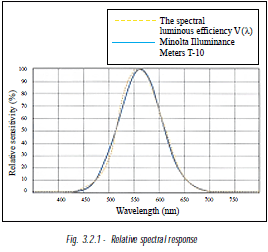Language of Light
3.Instrumentation
3.2 PHOTOMETER
A photometer can be defined as an instrument for measurement of visible light. Luminance and illuminance meters are the most common photometers and are easily available as turnkey systems. Luminous flux meters and luminous intensity meters are not widely available and usually have to be customised to the specific light measurement application due to the geometry of measurement involved.
The basic difference between radiometer and photometer, is that the latter must respond to light as the CIE standard observer. In other words, the spectral response of the photometer must follow the CIE Standard Luminosity Function V λ curve.
3.2.1 SENSORS

Non-filtered sensors, such as the selenium and cadmium sulfide, inherit a natural spectral response which approximate the V λ curve. However, its deviation from the Vλ curve makes it impractical for accurate photometry measurement and it is more commonly used in automatic light switches applications. Most modern filtered photometers use silicon photodiodes which incorporate optical filters in front of the sensor so that the transmission of the filter and the spectral response of the sensor can be combined to closely match the CIE V λcurve.
CIE recognised the need for a meaningful and internationally applicable method of specifying the quality of a photometric sensor. Hence, f1 value is developed for this purpose. The f1 value, specified in percentage error, represents the degree to which the relative spectral responsivity matches CIE V λ curve.

